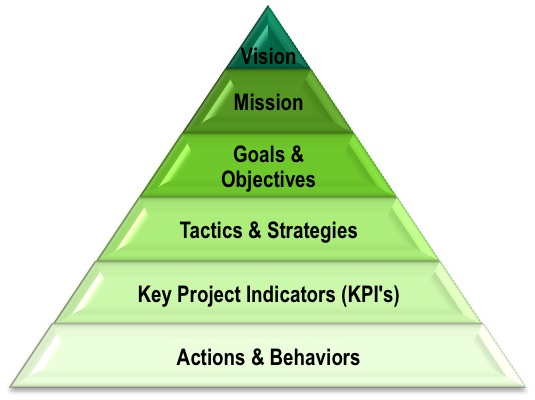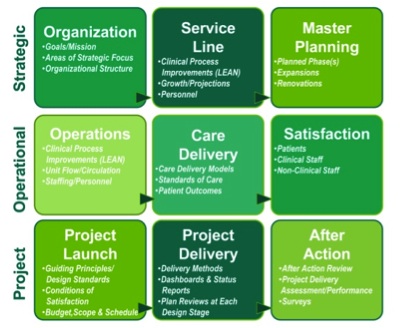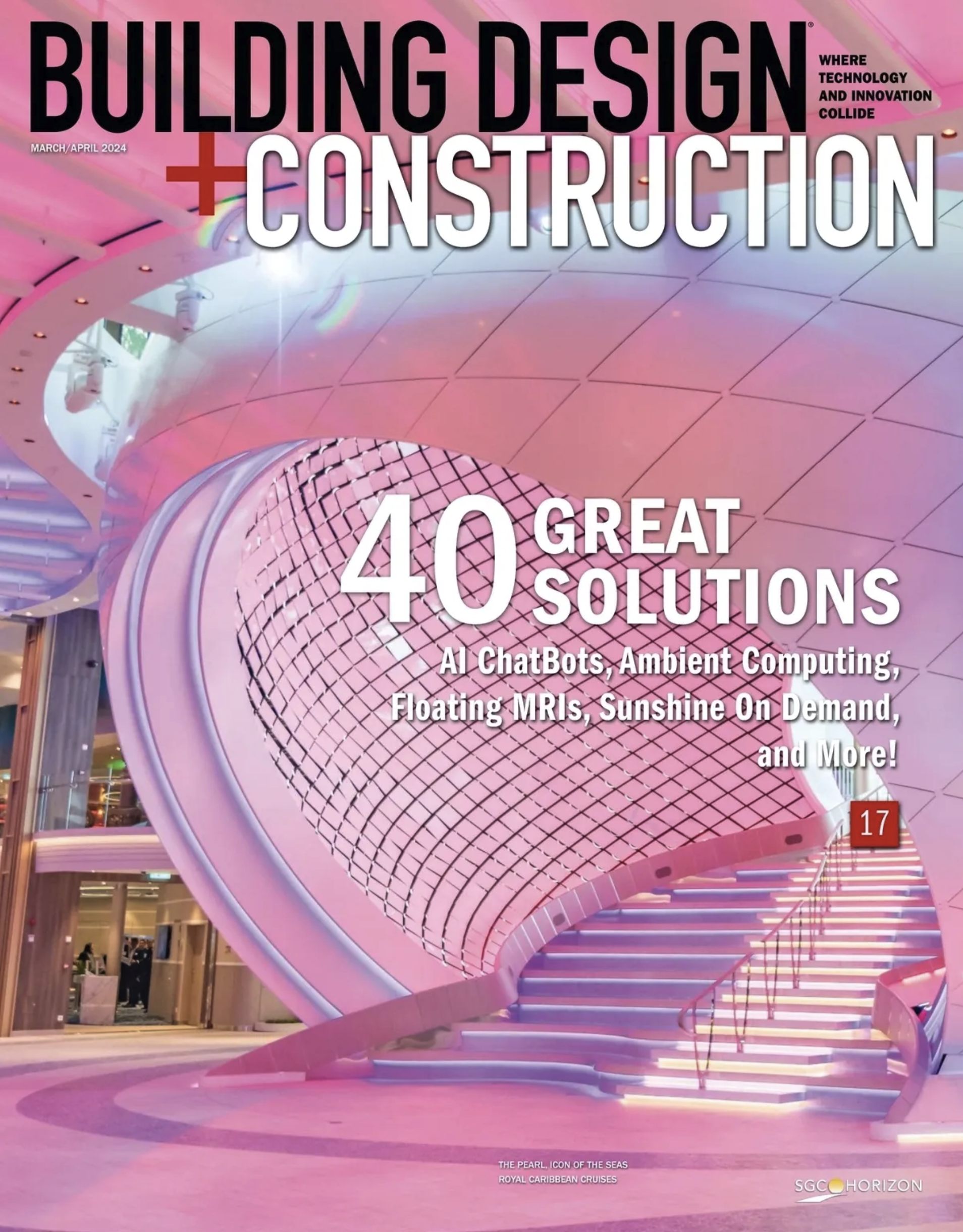Finding true north is just as essential for project teams and capital projects as it is for personal journeys and accurate navigation. Ask any surveyor. They will tell you that true north by definition is not magnetic North. To find true north from a magnetic compass you have to know the local magnetic variation and how it has varied over time. If you want to get from a point at the bottom of a map to one at the top, you must head true north.
Metaphorically, true north refers to one’s direction in life, as we are often uncertain where we stand, where we are going, and what is the right path for us personally. Knowing our true north enables us to follow the right path.
The same holds true for the life of a healthcare project. Most healthcare projects can take four to five years or more to come to fruition when you account for the time vested in pre- and post-construction. Because healthcare projects take years to implement and given the size of the teams involved, developing a "true north charter" is essential for a healthcare capital project in order to keep the entire team on track and moving in the right direction.
Defining a true north for a capital project takes time and effort, but can yield great benefits and the impact can be transformational. By communicating a shared vision and mission between the client, the project team, and the project, a true north charter can help inspire.
The charter outlines the required conditions of satisfaction that should be strategic, operational, and project specific in nature. The charter should also assign measurable goals to help the team track and assess their achievements through the life of the project. The underlying benefit of defining a true north charter is developing team dynamics built on trust, accountability, transparency, respect, and collaboration.
FINDING BALANCE IN CHOPPY WATERS
Navigating the capital planning and implementation process was much easier when the economy was humming. There was adequate access to funding, and the key driver for planning was volume. However, the healthcare industry has been rapidly evolving under the Affordable Care Act (ACA) and a soft economy. Healthcare reform has compelled health systems, hospitals, and physician groups to reduce costs and improve the quality of care-all with more regulatory requirements and less capital.
Changes to reimbursement methods, along with reductions in healthcare provider compensation, are forcing health systems to rethink their approach to balancing their assets and liabilities, including health care real estate. These factors, particularly when combined with a projected increase in demand for ~79 million aging baby boomers and ~30 million newly insured patients, has operators and owners of real estate repositioning portfolio requirements.
SETTING VISION AND MISSION
Finding true north in these choppy waters requires a keen sense of the market and a strong sense of the institution’s purpose. This starts with the mission and vision of the organization. While all health institutions exist to serve the community, the current market has forced many organizations to focus their efforts on meeting the greatest needs and offers specialization only when the market can support it financially.
A comprehensive strategic plan should highlight the organization’s vision, mission, and key areas of focus and be the baseline navigational tool for the institution and any capital spending. The true north for a capital project is then guided by the organization’s vision and mission statements, and further developed into a tangible project mission statement, guiding principles, target metrics, and target future state operations.
One Midwest health system’s vision and mission states:
“Our mission is to improve the health of the communities we serve through quality health care, education and research. Our vision is to be the best for those who need us. We value safety, compassion, respect and integrity.”
A sample of a project mission statement that could accompany such a corporate mission statement could be: “Through collaboration, team integration, and best practices, the project team endeavors to provide the expanded and improved facility within the owner’s schedule, efficiency, and budget goals while providing high levels of quality, safety, and team satisfaction. By delivering the XYZ Health System New Tower Project, the project team will meet the expectations set by the Health System board, administration, caregivers, support staff, and community through our innovation, collaboration, and professionalism."
STAYING ON TRACK
While the preceding project mission statement provides a framework for positive motivation and influence, it does not deliver the tangible metrics needed to offer feedback to the project team or client to know if the project is on the right path or that the desired outcomes have been achieved. In order to provide continuous feedback and help steer towards the projects "true north," goals must be tangible and measurable.
Guiding principles or goals should address the organization’s strategic and operational goals of the project, as well as the project-specific goals that address team performance. Each specific goal can then be supported by a tactic that can be mapped, tested, and monitored through specific key performance indicators, or KPIs. Prior to construction, KPIs for each tactic should be captured to establish baseline data in order for progress reports and post-occupancy data to be available for feedback and for comparison to future state.
Example strategic goal areas
- Increase Market Share
- Accommodate Private Bed Model
- Invest in New Model of Care
- Invest in Infrastructure to Decrease Operational Costs
Example Operational Goal Areas
- Maximize Staff Efficiency
- Improve Occupancy Efficiency by 15% (throughput)
- Reduce Cycle Times by 10%
- Reduce Medical Errors
- Increase Patient Satisfaction Scores
- Increase Flexibility of the Space
Example Project Goal Areas
- Safety During Construction
- Schedule Adherence
- Quality Product
- Cost Control
- Community Relationships
- Communication and Commitments
- Team Behavior and Relationships
ACHIEVING TRUE NORTH
Perhaps the greatest benefit to setting a capital project’s true north is the ability to provide feedback. It helps build trust for the project team, creates accountability, provides transparency, affords respect, and encourages collaboration for the entire team. Two reporting tools used to inform leadership and project teams on the success in navigating toward true north are the project status report (PSR) and the after action review (AAR).
The PSR, as its name suggests, provides an overview of your project’s trajectory. More than a reporting mechanism, the PSR should be a management tool that aides the team in achieving the established KPIs.
While many KPIs are tangible and measurable, others related to team dynamics and communication which may only be measured through a survey.
Still, other outcomes can only be measured post-occupancy. The AAR is a structured debrief process and knowledge management tool that provides accountability and insight. Perhaps the greatest benefit of the AAR is the lessons learned that can be applied to future work, teams, and processes. The AAR is developed by the entire project team after project completion. It captures true-north desired outcomes, measurable goals, tactics, and pre-construction metrics in order to summarize the capital project’s process, work products and post construction results.
CONCLUSION
Regardless of the terminology used, be sure to invest time in identifying the direction and process that will deliver the desired results for your project. By following the old adage of “plan your work and work your plan,” your project team will set the foundation to follow true north and ultimately achieve success. And in the process, you will find the underlying benefit of continual improvement.
About the Authors
Steve Higgs is Managing Director and Lora Schwartz is Principal Consultant with CBRE Healthcare.
Related Stories
Sports and Recreational Facilities | Apr 25, 2024
How pools can positively affect communities
Clark Nexsen senior architects Jennifer Heintz and Dorothea Schulz discuss how pools can create jobs, break down barriers, and create opportunities within communities.
Senior Living Design | Apr 24, 2024
Nation's largest Passive House senior living facility completed in Portland, Ore.
Construction of Parkview, a high-rise expansion of a Continuing Care Retirement Community (CCRC) in Portland, Ore., completed recently. The senior living facility is touted as the largest Passive House structure on the West Coast, and the largest Passive House senior living building in the country.
Hotel Facilities | Apr 24, 2024
The U.S. hotel construction market sees record highs in the first quarter of 2024
As seen in the Q1 2024 U.S. Hotel Construction Pipeline Trend Report from Lodging Econometrics (LE), at the end of the first quarter, there are 6,065 projects with 702,990 rooms in the pipeline. This new all-time high represents a 9% year-over-year (YOY) increase in projects and a 7% YOY increase in rooms compared to last year.
Architects | Apr 24, 2024
Shepley Bulfinch appoints new Board of Director: Evelyn Lee, FAIA
Shepley Bulfinch, a national architecture firm announced the appointment of new Board of Director member Evelyn Lee, FAIA as an outside director. With this new appointment, Lucia Quinn has stepped down from the firm’s Board, after serving many years as an outside board advisor and then as an outside director.
ProConnect Events | Apr 23, 2024
5 more ProConnect events scheduled for 2024, including all-new 'AEC Giants'
SGC Horizon present 7 ProConnect events in 2024.
75 Top Building Products | Apr 22, 2024
Enter today! BD+C's 75 Top Building Products for 2024
BD+C editors are now accepting submissions for the annual 75 Top Building Products awards. The winners will be featured in the November/December 2024 issue of Building Design+Construction.
Laboratories | Apr 22, 2024
Why lab designers should aim to ‘speak the language’ of scientists
Learning more about the scientific work being done in the lab gives designers of those spaces an edge, according to Adrian Walters, AIA, LEED AP BD+C, Principal and Director of SMMA's Science & Technology team.
Resiliency | Apr 22, 2024
Controversy erupts in Florida over how homes are being rebuilt after Hurricane Ian
The Federal Emergency Management Agency recently sent a letter to officials in Lee County, Florida alleging that hundreds of homes were rebuilt in violation of the agency’s rules following Hurricane Ian. The letter provoked a sharp backlash as homeowners struggle to rebuild following the devastating 2022 storm that destroyed a large swath of the county.
Mass Timber | Apr 22, 2024
British Columbia changing building code to allow mass timber structures of up to 18 stories
The Canadian Province of British Columbia is updating its building code to expand the use of mass timber in building construction. The code will allow for encapsulated mass-timber construction (EMTC) buildings as tall as 18 stories for residential and office buildings, an increase from the previous 12-story limit.
Standards | Apr 22, 2024
Design guide offers details on rain loads and ponding on roofs
The American Institute of Steel Construction and the Steel Joist Institute recently released a comprehensive roof design guide addressing rain loads and ponding. Design Guide 40, Rain Loads and Ponding provides guidance for designing roof systems to avoid or resist water accumulation and any resulting instability.


















